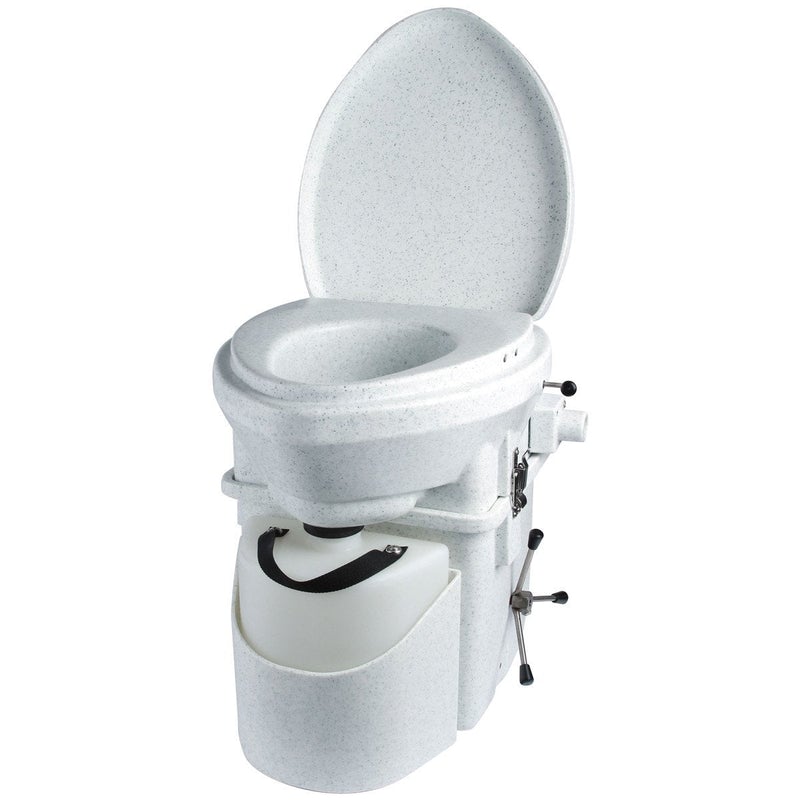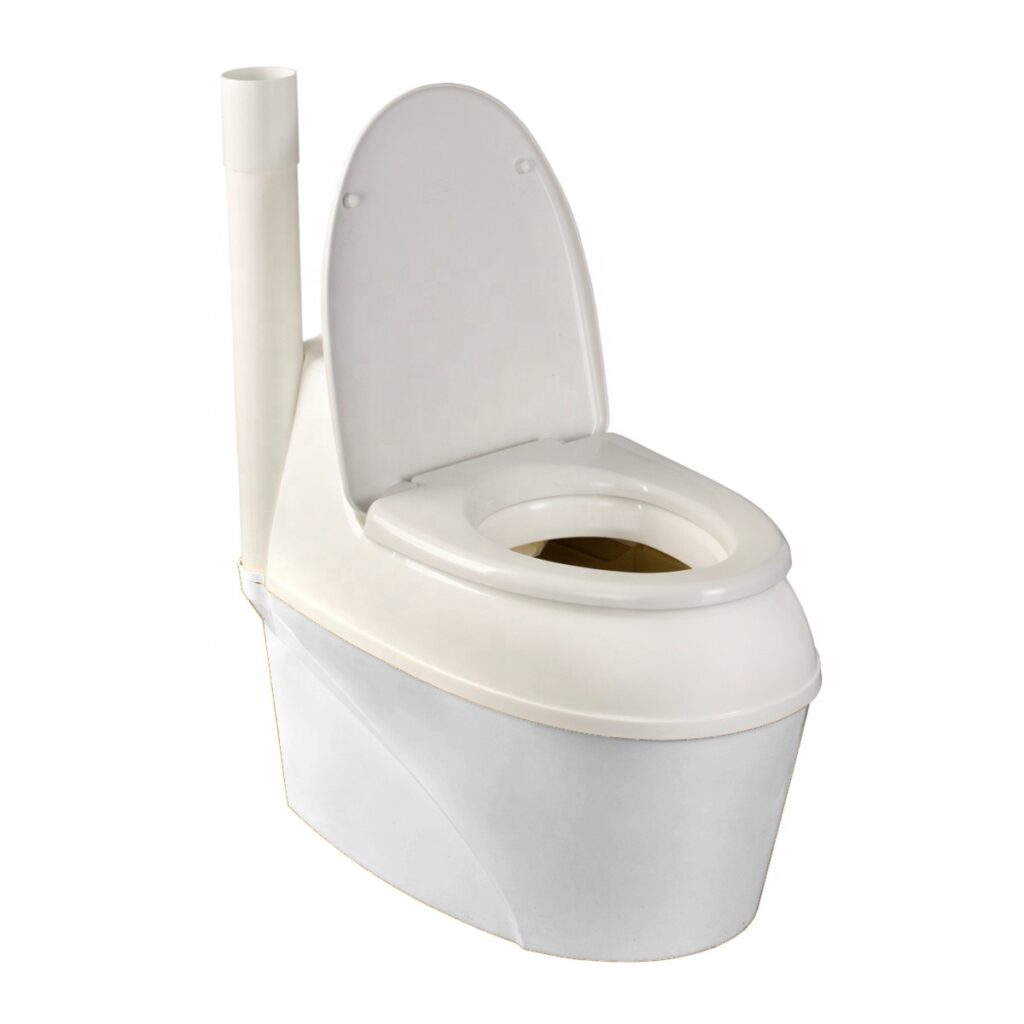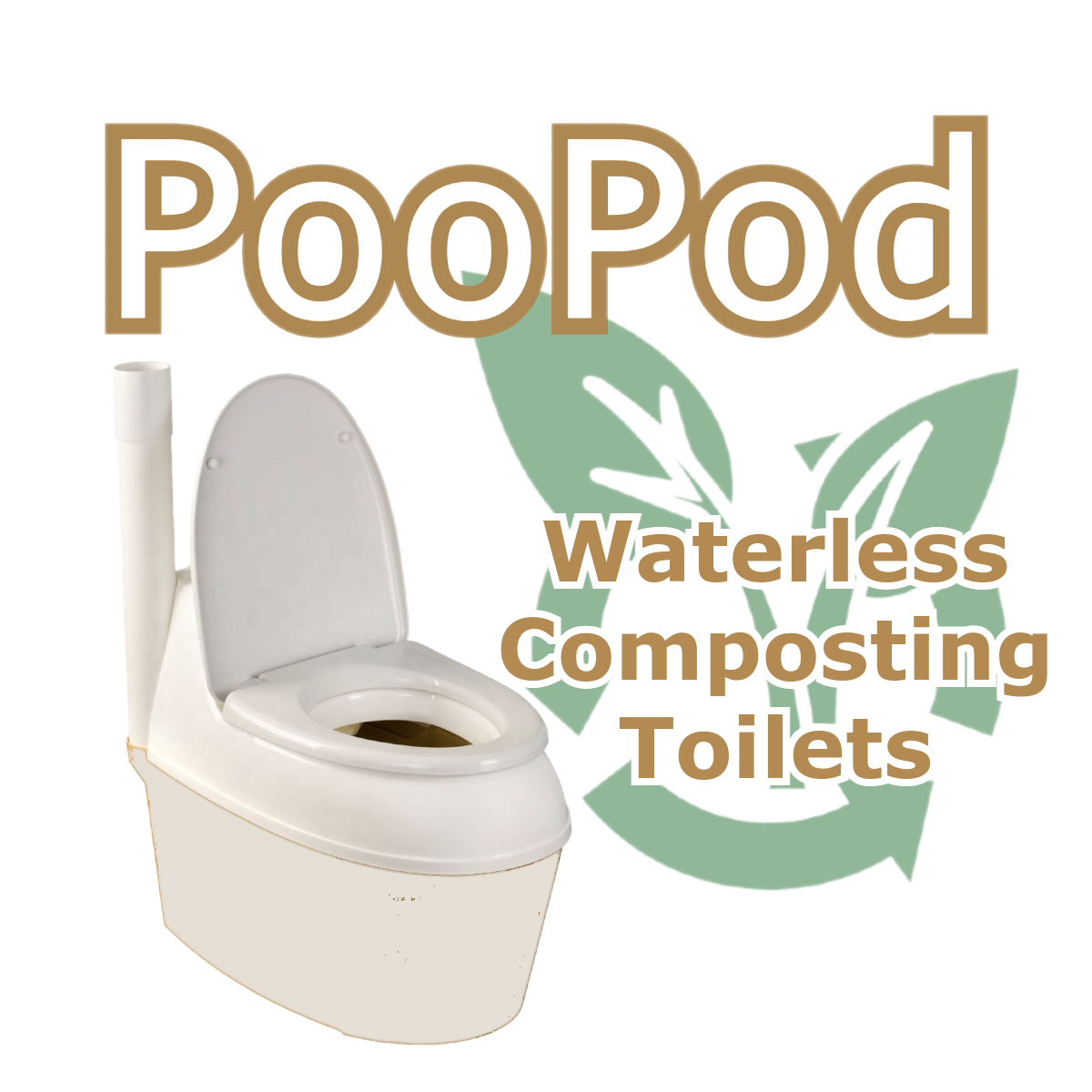Many know the mess and smell of using an RV or chemical toilet. If you despise cleaning and emptying the black tank on your RV or trailer, you should consider switching to a composting toilet. Yes, you still have to empty it, but it’s not nearly as messy or smelly.
With a conventional toilet, water flushes down solids and urine, and they mix to make a nasty soup of things that should be left to your nightmares. A composting toilet, separates urine from the “Number Two”, and when you empty the holding tank, all you see is the makings of dirt. Dumping dirt into a composting bin, or a hole in the ground, is much simpler, and better for the environment. Many continue the composting process in a bin, and use the compost for planting. Yes, Humanure is a real thing. That means the results are not as offensive.

(download free book about humanure)
The best part is, you won’t have to use your black tank at all.
Composting toilets are safe. They are so safe in fact, that they are installed in many national parks. Solid waste in small quantities is treated much the same as pet feces, diapers, and other compostable items.
Many commercially available toilets use a predetermined amount of peat moss or coco-coir and then as you “do your business”, urine is received in a jug, and the moss is mixed up until emptying is required. These small toilets with crank system work well, but they are smaller than a regular toilet and make it difficult to comfortably use. Some larger, or standard sized toilets, are available, but some of these systems cost well above $2000. The Poo-Pod Waterless Composting Toilet, is a unique system, that meets the demand in the middle of the tiny toilets with cranks, and the super expensive toilets. A good composting toilet should be easy to set up, easy to maintain, and inexpensive to operate. The small toilets with a crank and a urine tank leave you constantly wondering if it is time to empty, and then one-use-too-many, leaves you with a mess or a leaking toilet. The unique Poo-Pod system uses a holding tank for the peat moss to cover your number twos, and the urine drains out the back of the toilet into the ground, so you never have to worry about overflowing. When the toilet fills up, it is very easy to see when it is time to empty the holding tank.

Installing a Composting Toilet
No water hookup is needed for the toilet itself because it doesn’t use water. A composting toiler just sits on the floor, without the need to connect to water, waste outlets or even to the floor, if you want the ability to move it. For the toilet to work efficiently, you will need an electrical connection (12 Volt DC usually) to run the toilet’s small fan, and you will need to drill through a surface or wall for a small ventilation duct.
The smaller composting toilet typically requires assembly. They may require, brackets and fittings to by screwed or mounted to the floor to secure the toilet from falling over or wiggling. The Poo-Pod Toilet and some real sized toilets, are easily mounted to the floor with 4 screws.
Using a Composting Toilet
You must set up the toilet for use by adding coconut fiber (sometimes called coco coir) or peat moss in the solid waste bin, hydrating the material before spreading it out at the bottom of the bin. This must be repeated after each dumping.
Most composting toilet with a urine holding tank requires sitting, where as the Poo-Pod does not. You will find, most men, prefer urinating the way nature intended….outside. :-). Without a way to separate, drain or evaporate the urine, mixing would create a stench, so be sure to teach every user to sit on the smaller crank style toilets. A plastic bottle collects urine at the front of the toilet and has to emptied on a regular basis.
The larger composting bin collects solid waste beneath the bowl. Organic material, such as coconut fiber or peat moss, is placed in the composting bin to collect an mix with solid waste. For two people, a $4 bag or block of peat moss will probably last 6 months to a year.
On the small crank toilets, each time solid waste is put into the bin, you must get down on your knees and turn the handle to mix it with the organic matter. On the Poo Pod Toilet, while standing, you just simply give the Moss tank a spin back and forth and that’s it. You will use a little more moss on the Poo Pod Toilet than on the small crank toilets, but peat moss is really cheap and easy to find at local hardware stores.
Advantages/Disadvantages
Advantages
- No Plumbing required and No water connections required.
- Poo-Pod Large toilet using regular sized toilet seat.
- Poo-Pod-No urine bottle required.
- You will eliminate black tank odors, since you won’t be using the tank.
- You’ll have no need to empty a black tank—ever.
- You are likely to need to dump solid waste less often—perhaps every 3-5 weeks—than you would a black tank.
- You’ll use less water without a water-operated toilet, so your fresh-water supply will last longer.
- Poo-Pod Stand up to pee
- Emptying both the urine bottle and composting bin are relatively easy.
- Composting toilets are somewhat portable, so you can use place one inside or outside.
Disadvantages
- There’s that sitting regimen for the small crank toilets, which some men may not like. If you have bad knees, you may want to securely install a grab bar near the toilet since the crank toilets are so small
- Small Crank Style Toilet- Sit down to pee
- On small crank style toilets, you’ll have to empty the urine bottle more often than a black tank. Having extra urine bottles is advisable. They have screw-on tops, so they don’t leak.
- If you do not compost, then you will need to dig a hole, or dump contents into a plastic bag and dispose of the bag with regular garbage.
Where To Dispose of Waste
Dumping Urine:
Here are some places you should be able to empty the urine bottle from your composting toilet:
- On your own property
- At a dumping station.
- Any place you can urinate. So, a public toilet, such as those in a national park, or a toilet in a fast food or big box store , could take urine from a bottle.
- On the ground or in a hole. Not just anywhere is acceptable, but many places are. Dirt roads in remote spots are good.
- Not near rivers, streams, and storm drains.
- Never on private property without permission.
Dumping Waste:
Solid waste portion of the toilet is not quite fully composted, when you need to dump. It can take 6 months to a year to fully compost, depending on climate. Even though it is not fully composted, it is not considered hazardous by the EPA. Your bag of waste and fiber is the same classification as solid waste or municipal waste. It’s actually not as bad as a disposable diaper, which mixes solid waste with urine and contains more non-biodegradable plastic.
Here are places for dumping solid waste:
- In the compost pile at a municipal area, park or campground. One is typically available.
- In a trash or brush receptacle. Place the waste inside a plastic or compostable bag before placing in a trashcan or dumpster. Landfills accept this as a type of municipal waste.
- Burying on your own property.
- Burying on public land. Some parks may bar this, but generally speaking if you’re in a wilderness area, you may dig a cat hole a least 8 inches deep and bury solid human waste, the same as you would if defecating outdoors while camping. The smaller the amount, the better. The bigger the amount, the deeper the hole should be. For multiple burials, use different spots.
Always read the instructions that come with your toilet. Not all models are the same. And check with EPA regulations before you dispose of waste.
